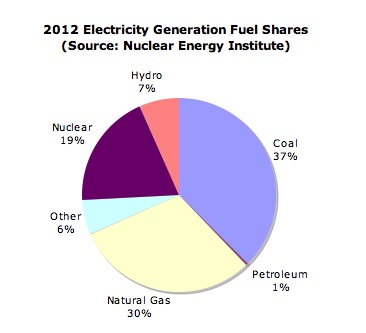The President’s climate change program offers nothing new to impact carbon emissions.
On June 25, President Obama announced a goal of curbing greenhouse-gas emissions 17% from 2005 levels by 2020. The key program to accomplish this is “…establish carbon pollution standards for both existing and new power plants.”
This would be the first-ever federal effort to regulate greenhouse-gas emissions from electricity generating power plants, the source of about one-third of such carbon emissions in the U.S. The main strategy is to reduce the use of coal, in favor of cleaner, less carbon emitting fuels, mainly natural gas.
Obama is only a decade behind! In the past decade (see charts), the electric utility industry has already reduced its coal usage by over 1/3, from 51% of total electricity generation in the U.S. to 37% in 2012, as reported by the Nuclear Energy Institute .
Natural gas has taken up all of the slack, because natural gas fired plants are physically smaller, can be situated near customers in large cities, have much shorter regulatory approval cycles, and because horizontal deep fracking drilling has made natural gas plentiful and cost effective, now and in the future for North America. Over 90% of the new capacity for electricity currently in the approval process in the U.S. is for natural gas fired plants. Natural gas’s portion of total electricity will continue to rise, with or without regulation by the federal government.
President Obama’s plan includes other measures meant to reduce emissions, including $250 million in federal loan guarantees for cleaner fossil-fuel energy projects; new fuel-economy standards for heavy trucks; and greater cooperation between the U.S. and major economies including China, India and Brazil. These proposals are either too small to have a meaningful impact, or they lack any specific proposals that could achieve meaningful results. Big talk, but little results will come.
Mr. Obama’s proposals don’t require congressional approval. One can expect legal and congressional challenges to regulating carbon emissions from power plants. But the electric utility industry will continue its progress away from coal, with or without those regulations.



